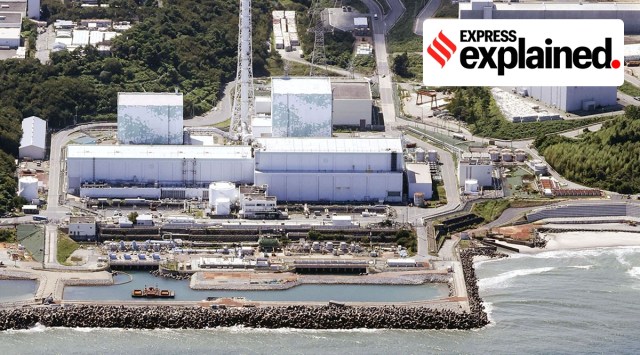Why is Japan releasing Fukushima water — and is it safe?
In response, China announced it is suspending Japanese seafood imports with immediate effect. South Korea’s largest opposition party has amped up protests.
 The Fukushima Daiichi nuclear power plant in Okuma, Japan. (Image source: AP)
The Fukushima Daiichi nuclear power plant in Okuma, Japan. (Image source: AP) Japan started to pump treated radioactive water from the Fukushima Daiichi nuclear power plant, destroyed in a 2011 earthquake and tsunami, into the Pacific Ocean on Thursday.
In response, China announced it is suspending Japanese seafood imports with immediate effect. South Korea’s largest opposition party has amped up protests.
Why is the water being released?
Several reactors at the nuclear power plant melted down after the 2011 earthquake and tsunami. Since then, workers at the now-defunct plant have been cooling the reactors by using water, which becomes contaminated. All the radioactive water, about 350 million gallons, is stored in more than 1,000 storage tanks at the site. But the tanks are nearing capacity, leading the workers to release water into the ocean after filtering it.
How is the water being filtered?
Tokyo Electric Power Company Holdings (TEPCO), operator of the nuclear plant, is using a filtration system called the Advanced Liquid Processing System (ALPS). The system can remove all radioactive contaminants from the water except tritium. Tritium is a form of hydrogen that occurs naturally in the Earth’s atmosphere, and is part of water itself. So it isn’t possible to create a filter to separate it from the contaminated water.
To tackle the situation, TEPCO has said it will dilute the contaminated water using seawater to ensure that the concentration levels of tritium are well below the safety standards. If the levels of tritium remain too high after filtration, it will repeat the process before releasing the water. Moreover, the water will be discharged slowly, over decades.
Is the released water safe?
The issue has polarised experts. Japan and the International Atomic Energy Agency (IAEA), which has peer-reviewed the country’s water release plan, have said “discharges of the treated water would have a negligible radiological impact to people and the environment”.
The Japanese government also says tritium isn’t dangerous — and even if it enters into the body, the risks are low.
Many experts, however, have accused officials of downplaying the level of radiation in the water. Many also allege that apart from tritium, there are other radioactive elements that remain in the water even after filtering.
“The contaminated water contains many radionuclides, which we know impact the environment and human health — including strontium-90,” Shaun Burnie, senior nuclear specialist for Greenpeace, told DW.





- 01
- 02
- 03
- 04
- 05

































